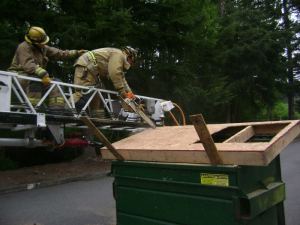With all of the acronyms, studies, and science being brought into the fire service today, I often hear of people clamoring for a simpler time. A time when the job was what they describe as simpler. Even as a believer in a lot of these different studies, and I feel that the fire service should be an educated fire service, but at the core of our job what we do everyday has not changed. A lot of these concepts are not even “new” if you are familiar with any fire service history. I learned about “transitional attack” back in 1996 when taking my first firefighter 1 class at the ripe old age of 16.
However I realize that young firefighters out there making their way into the fire service all over the country can be bogged down with some of this new information, and or tactics. I have had to utilize my college degree more than once to decipher some of the nuances of these studies. So in that spirit here are Averagejake’s rules of the fire service!
Always wear you PPE!
No matter the call, no matter the building, no matter your years of service ALWAYS wear your personal protective equipment! Or even simpler wear the things designed to protect you! This begins with your seat belt while responding to and returning from responses. If you are going to an EMS run, put your gloves on. If you are going to a building or car on fire put on your turnout gear and SCBA. If the EMS call requires a mask, eye pro, or gown then put it on. If the fire requires you to be on air due to smoke exposure in the front yard then put it on.
If you are on an Engine Company, Always have something that can put a fire out!
Tool selection is a big topic in almost any firehouse in America. Everyone has a preference on what they like to carry, and most have a ton of merit based on individual likes, and district needs. What cannot be up for debate is that the primary mission of an Engine company is to extinguish fire. Therefore if you are responding to a fire alarm, building fire, car fire, etc. you must come off the rig and grab some sort of extinguishing device. This can be a water can, hose pack, pulling a line, ABC extinguisher, or Indian Pack. I like to carry a water can when investigating residential occupancy, and a hose pack when investigating multi-family and commercial occupancies. This way if I find a fire I can either hold it in check with the can, or isolate the fire by closing the door and back stretch the line back to a water source (engine, leader line, standpipe).
If you are on a Special Service Company (Truck,Squad,Rescue) always have something that breaks stuff!
Yes search and rescue is a primary function of Special Service companies, and I do not want to down play that. However a majority of what companies do is open the building up. They force entry, they ventilate, they overhaul all of these things require tools! When I was assigned as a truck firefighter I carried a 6 foot NY Roof Hook and 30 inch halligan pro bar. This allowed me to open doors, break windows, pull ceilings, open walls, open floors, and just about anything else you can think of. Again people have preferences on which tools they like to have and that is fine, just know the buildings in your district and choose the ones that best fit them.
TRAIN EVERYDAY!
This one should be self explanatory but sadly it is not. Good enough is not good enough when it comes to our job. We should be striving for excellence in every aspect of our job. Training our fire skills, EMS skills, and our physical fitness to elite levels is the secret of fire service success. The funny part about it is that it is the worst kept secret ever! Everyone knows it, yet seem to shy away from it. I do not know if it is laziness, apathy, or uncaring. However no one forces ANYONE to be a firefighter, we all chose to be here. So if we are going to be here, and lives are in our hands, then we have the responsibility to be the best at it we can be. So spend an hour in the gym, and an hour working on fire skills every shift day. When your off read at least one fire related article a day. Just that little bit of work will take you to elite levels of firefighting.
I do not mean to trivialize the complexities of our profession. We operate in highly dynamic environments, and have to have tremendous skill sets in order to mitigate emergencies. Never stop seeking elite levels of the fire service, but if you get lost or have a brain lapse remember to wear your gear, have something that puts fires out, have something that breaks stuff, and train every day. That should get you through until you get back on track.
As usual thanks for reading, spread the word, and STAY SAFE!


You must be logged in to post a comment.